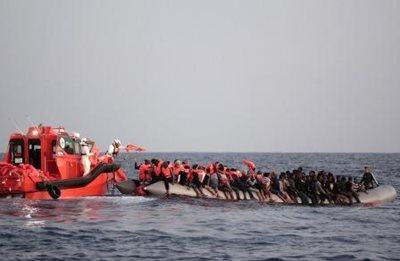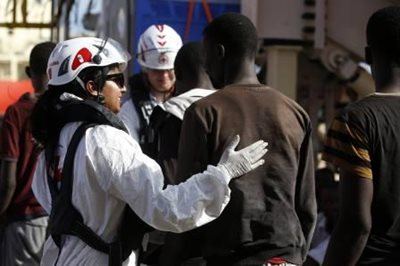In October 2016, Canadian Red Cross aid worker Dr. Kim de Souza met a little girl while working aboard
The Responder, a rescue ship in the Mediterranean Sea. The young girl, like many the ship rescued, was fleeing violence in her home country – in this case, Syria. Kim tried a number of times to engage the girl, who she describes as having “the saddest eyes I’d ever seen,” but had no success.

The young girl never smiled or said anything, but she did watch Kim as she interacted with patients aboard the ship. On the day she left, the girl came up to Kim and gave her the warmest embrace and didn’t let go. The girl then presented her with a picture she’d drawn of children playing under the sun with a smiley face. Kim was touched – “the picture spoke a thousand words from a child who didn’t say anything. I think she finally felt safe.”
This is the work
The Responder – a
rescue ship run jointly by the Italian Red Cross and Migrant Offshore Aid Station (MOAS) – does every day. The rescued migrants have endured treacherous conditions in small boats, called dinghies, which are often over capacity and incredibly unsafe. During her four-week assignment, Kim was the only doctor on board the ship, and worked with a medical team consisting of a nurse and a paramedic.
Over the four weeks, Kim estimates the ship rescued about 2,300 people. In order to assess the migrants coming aboard with such a small team, it was essential for the health team to be right up front as the migrants came on board. This allowed the team to visually assess the migrants one by one as they boarded the ship, looking for individuals who were in visible distress, had trouble walking, looked dehydrated or had visible injuries.

There were times when
The Responder, which had a capacity of just under 400 people, would rescue multiple dinghies in a short period of time. Kim remembers the ship having close to 800 people on board at one point. The types of injuries were wide ranging – burns and skin wounds were most common, as were dehydration and chronic illnesses that had never been addressed. These individuals also varied in age; the youngest rescued was a two-day-old baby, and the oldest an 81-year-old woman. Many came from Syria and Nigeria, but there were many other countries of origin as well.
The stories that the migrants told were often beyond anything we here in Canada can imagine. Kim remembers in particular the story of a young man from Libya, who told her about being kidnapped while walking down the street and being taken to a forced labour detention centre. He escaped into the jungle with another detainee – while being fired upon – and eventually made it onto a dinghy bound for Europe. The two men were so grateful to be rescued that they often tried to help the staff and crew on board the ship in anyway they could.
Kim describes most of the assignment was an “eat when you can, sleep when you can” situation. Still, despite the hectic environment and lack of sleep, she says it was an “incredible privilege” to interact with and help migrants at the first point of contact. In addition to the young Syrian girl and the young men from Libya, Kim met many other passengers whose stories she’ll keep with her. Looking back, she says she’s “so fortunate” to have had this experience.